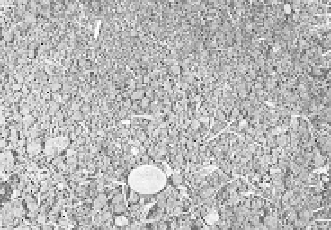Agriculture Reference
In-Depth Information
Type of Aggregate
Descriptive Features and Characteristics
Spheroidal
Roughly equidimensional and bounded by curved or irregular
surfaces that do not fit against adjacent aggregates. Those that are
relatively dense and nonporous are called
granules
. Very porous
aggregates, often of dark color throughout, are called
crumbs
(fig. 3.2a). Crumbs are formed by the interaction of soil organisms,
roots, and mineral particles in topsoils under grasslands and
deciduous forests. They contribute to a desirable structure.
Figure 3.2
(a) Surface soil crumb structure, class 0.5-1 cm.
Blocky
Equidimensional with curved or flat surfaces that are mirror images
of surrounding aggregate faces. Those with flat faces and sharply
angular vertices are called
angular
; those with a mixture of rounded
and flat faces and more subdued vertices are called
subangular
(fig.
3.2b). Blocky aggregates are common in the subsoil of loams and
clay loams where they often have distinctive colors, because the
surfaces are coated with organic matter, clay, or sesquioxides. They
may have live or dead roots attached, or show distinct root
impressions. A blocky structure in the subsoil usually indicates a
good rooting environment for vines.
Figure 3.2
(b) Subangular blocky aggregates, class 2-3 cm.
Platy
Aggregates with a limited vertical dimension. An aggregate that is
thicker in the middle than at the edges is called
lenticular
(fig. 3.2c).
Aggregates occur in an A horizon immediately above an
impermeable B horizon or in the surface of soil compacted by
machinery. Water moves laterally rather than vertically through a
soil horizon with platy structure, which is undesirable in vineyards.
Figure 3.2
(c) Platy aggregates in the A2 horizon of a sodic soil,
class 0.5-4 cm.
Prismatic
Aggregates bounded by flat vertical faces, with sharp edges and flat
tops, for which the horizontal dimension is limited compared to the
vertical. The brick-red aggregates in figure 3.2d indicate a well-
drained soil, but large prismatic aggregates that occur in the
B horizon of clay soils subject to frequent waterlogging indicate
poor drainage, an undesirable condition in vineyards.
Figure 3.2
(d) Prismatic aggregates in a clay subsoil, scale is 10 cm.
Columnar
The same as for prismatic, but with rounded caps (fig. 3.2e).
Columnar aggregates are typical of the impermeable B horizons of
Na-affected soils; the main pathway for water movement is between
the columns. However, because Na-clays swell when wet (box 3.1),
these pathways close and subsoil drainage is severely impeded, which
is very undesirable in vineyards.
Figure 3.2
(e) Columnar aggregates in a sodic subsoil, 12-15 cm
across the columns. Photographs by the author. See color insert.





